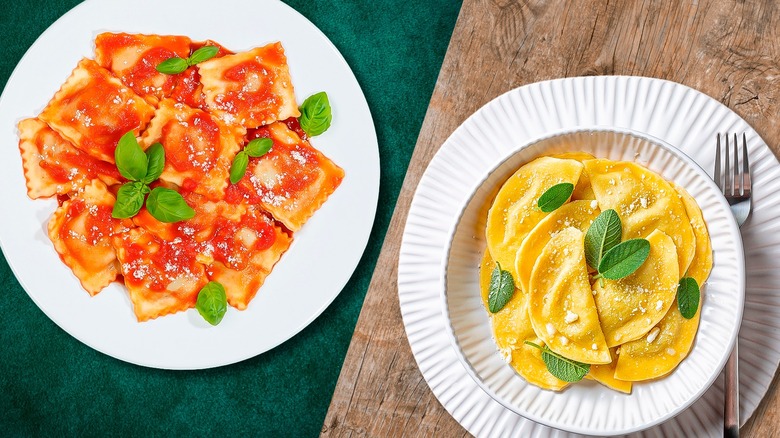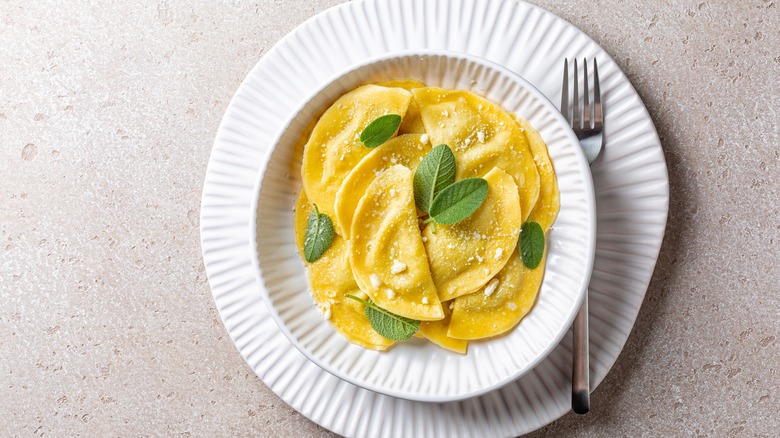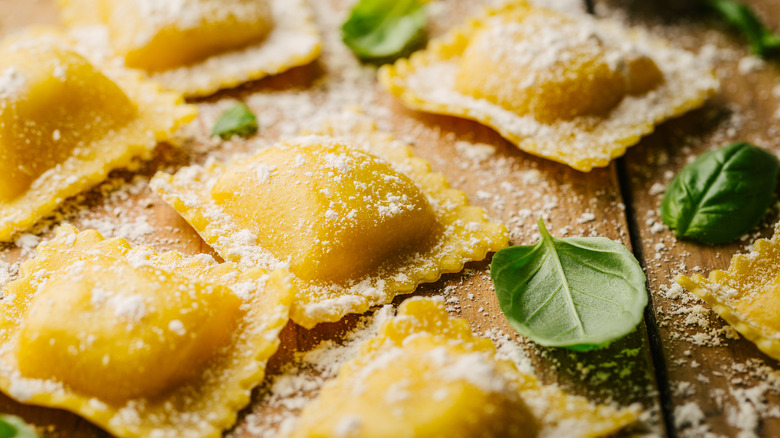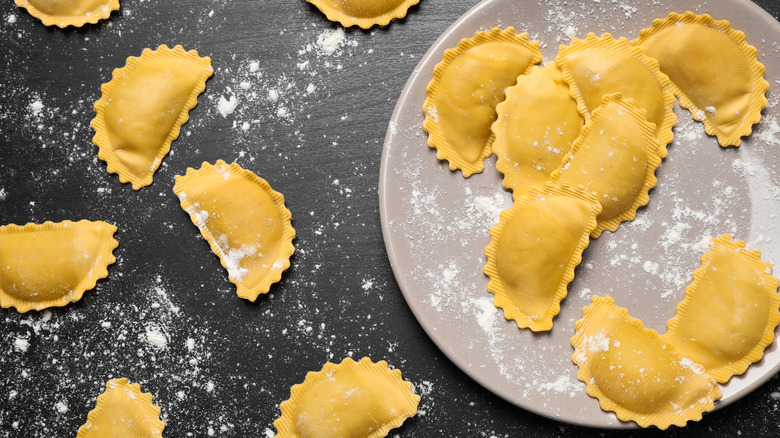The Difference Between Mezzelune And Ravioli Simply Comes Down To Shape
Take a stroll down the pasta aisle at your local grocery store, and it's easy to see there are quite a few different shapes available. But when you turn to freshly made artisan pasta, there are far more options that are possible — some with few distinctions from one another. Two pasta shapes that might appear the same to some include ravioli and mezzelune. A closer look, however, reveals subtle differences that set them apart. Let's unravel the subtle yet surprising secrets of mezzelune and ravioli, exploring their origins, shapes, and when to use each delicious variation of the pasta shape.
At their core, mezzelune and ravioli do have a lot in common. They are both filled pasta shapes traditionally made with a simple dough consisting of flour, water, and an egg, stuffed with savory fillings, and topped with delicious pasta sauces. However, the key difference lies in their shape. Mezzelune, which translates to "half moons" in Italian, are crescent-shaped or half-circle pasta pockets, while ravioli, which comes from an Italian word meaning "to wrap," are usually square or round with two layers of dough enclosing the filling.
What is mezzelune?
To begin, let's get familiar with the elegant mezzelune pasta. Originating in the Alpine Mountain Region between Italy and Austria that includes the towns of Tyrol and Trentino, mezzelune are a type of stuffed pasta traditionally filled with a variety of savory ingredients, such as ricotta cheese, spinach, herbs, and sometimes mushrooms. While meat and seafood are not typically used to fill these pastas, they could be filled this way if you so choose.
To create mezzelune, pasta dough is rolled out into thin sheets and cut into circles using a round cutter or glass. A small spoonful of filling is placed in the center of each circle, which is then folded over and sealed to create the crescent shape. The edges are pressed together for a clean and simple seal, though some might use their fingers or a fork to create crimped or wavy ridges to seal the pocket shut.
What is ravioli?
Next up is ravioli, a classic square or circular shape that many people are familiar with. Originating in the northern Lombardy region of Italy, ravioli became a staple of Italian cuisine in Milan and Mantua, beloved for their versatility and delicious flavor combinations. This particular variety of ravioli dates to the 1500s when it was served to the Milanese elite.
To make ravioli, the pasta dough is once again rolled out into thin sheets and topped with a layer of filling. This time, however, another sheet of pasta dough is placed on top, and the two layers are pressed together to seal the edges and create individual ravioli pockets — using similar techniques for simple or stylish seals. Traditionally, ravioli fillings include ricotta cheese, vegetables, meat, and seafood, though the possibilities are truly endless. Of course, there are seemingly an equal number of sauces that can be labeled over the dish as well.
When to use one shape over another
While mezzelune and ravioli may have distinct shapes, they are often used interchangeably in recipes, depending on personal preference and the desired presentation. Both pasta shapes are versatile and can be filled with a wide range of ingredients. From seasonal spins, like sweet potato ravioli, the course of the meal, or your personal preferences, there are plenty of ways to use both of these pastas.
In general, mezzelune are well-suited for dishes where their crescent shape can be showcased. They are particularly perfect for lighter dishes such as starters thanks to their smaller size and half the dough that is used to make ravioli. They are often served with a light sauce that complements their delicate form. Try a simple marinara, silky butter sauce, or even an herbed cream sauce.
Ravioli, with their flat, full shape, are ideal for heartier dishes, such as those with a rich, flavorful sauce that can cling to their flat surfaces. Because these pasta pieces are thicker, consider serving them as a main course. Thanks to the interchangeability, you can use similar sauces for ravioli too. Try using a rich Pomodoro sauce, a thickened butter sauce, or even Alfredo.
Ultimately, whether you choose mezzelune or ravioli for your next pasta creation, you're sure to enjoy a delicious and satisfying meal. With their versatile shapes and endless filling possibilities, these beloved pasta varieties are a testament to the culinary creativity and ingenuity of Italian cuisine.



